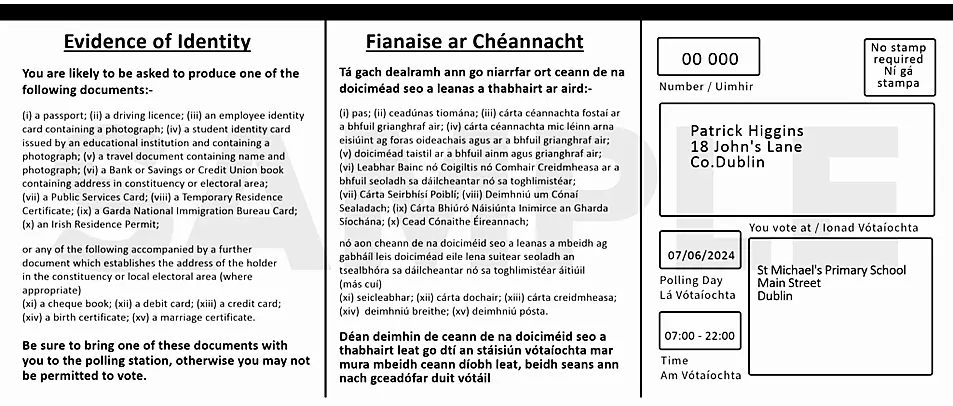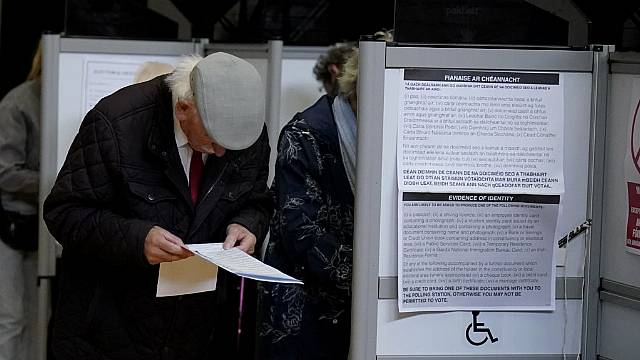Ireland is heading to the polls to decide who should form the next government.
Here is an overview of everything from how to find out if you’re registered, where to go, what to do and how the Irish voting system works.
Am I registered?
If you’re unsure whether you’re registered, you can still visit checktheregister.ie – select your local authority and search using your full name and address or Eircode.
When can I vote?
Polling stations will be open from 7am until 10pm on Friday, November 29th.
Do I need a polling card?
No. Even if you haven’t received one, you might still be on the register.

If you’re registered to vote but haven’t received a polling card, you can just go to your polling station.
Where is my polling station?
Polling stations are often local schools or community buildings that are close to your registered address. Your polling station will be listed on your polling card.
If you haven't recevied a polling card, you can use checktheregister.ie or you can call your local authority to see if you are on the register, and where your polling station is.
Do I need to bring ID to the polling station?
Yes – especially if you don’t have a polling card.
When you arrive at the polling station, you’ll be asked for your name and address, and possibly a form of identification to confirm that you are who you say you are.
Once staff at the polling station find your name is on the Register of Electors and are satisfied with your identity, they’ll give you your ballot paper.
How do I vote?
Ireland uses proportional representation for elections, with each voter getting a "single transferable vote".
This means you can order in preference, marking 1, 2, 3 and so on for your preferred candidates.
It also means voters can choose to vote for as many, or as few candidates as they like, in order of their preference.
Your first preference vote – the candidate you give their number 1 vote to – is most important and is always counted. Your second (and further preferences) may be counted if your preferred candidate is eliminated at the end of a round of counting, or is elected with a surplus.
Do not make any other mark on the ballot paper. If you do, your vote may be considered invalid/spoiled and not counted.
You should not write X or tick the box beside candidates, as this could also spoil your vote.
When you have voted you should fold your ballot paper, return and place it into the ballot box at the same station.
How does the count work?
When polling is over, all ballot boxes are taken to a central counting place for each constituency. The count starts at 9am on the day after polling day.
Once all the ballot boxes are opened, a reconciliation process takes place in which the number of ballots issued at the polling centre is checked against the number of ballots that were in the ballot boxes. Each ballot paper is checked to ensure that it has been properly completed, and any potential spoilt votes are set aside. The number of ballot papers are counted to determine the total poll, the total number of votes.
The quota is then calculated on the basis of the total valid poll. The quota is the figure that, if reached, guarantees the election of a candidate. It is possible to get elected without reaching the quota, but this can only happen when all other candidates are excluded.
How is the quota calculated?
The quota is calculated by taking the (total number of valid ballot papers) dividing it by (the number of seats to be filled plus one) and then adding one.
So, in a four-seat constituency with a valid poll of 60,000 the quota is as follows: (60,000/4+1) +1 -= 12,001.
The quota is a formula calculated on the basis of the lowest possible number of votes that can be filled by the number of candidates to be elected. In the above example, which is a four-seat constituency, it is only possible for four candidates to reach the quota of 12,001 votes each, as this would only leave 11,996 votes left.
If your first choice candidate reaches or exceeds the quota on the first count, they are elected.
So what is the surplus?
The surplus is the number of votes a candidate has over the quota.
The first count is normally the only time that all of a candidate’s second preference votes are counted. If a candidate is elected at the first count, then all their votes are used to calculate the proportion of surplus that will be given to each candidate.
Where a candidate reaches the quota after the first count, only the ballot papers that brought them over the quota are examined (the votes that were transferred from the previous count).
If two or more candidates are elected at the same time, then the surplus of the candidate with the largest vote is distributed first.
However, a surplus is only distributed if it can achieve one of the following:
- Elect the next highest continuing candidate;
- Bring the lowest continuing candidate level with or above the second lowest continuing candidate;
- Qualify the lowest continuing candidate for recoupment of their election expenses or deposit (if applicable).
- The question of whether a surplus is to be distributed is considered after each count on the basis of the surplus(es) then available.
What about eliminating candidates with the lowest votes?
If nobody reaches the quota after a round of counting, then the candidate with the fewest number of votes is eliminated, and all their votes are distributed.
More than one candidate can be eliminated after a round of voting if it is clear that they cannot be elected, and they cannot qualify to have their election expenses repaid.
And then we get a government?
Once all the seats have been filled, the Dáil votes on who will serve as Taoiseach and lead a government. If one party has a majority, or has the support of other parties and/or independents, it will be clear who will lead the country into the new Dáil session.
If there is no clear majority, there may be a period of negotiation, where groups of parties and/or independent TDs try to build a majority.
If there is no clear winner, and TDs are unable to decide who should form a government, the Taoiseach (from the previous government) may have to ask the President to dissolve the Dáil again.
How is a government formed?
A party needs a majority (51 per cent) to form a government. If two or more parties come together, like the current government, it is called a coalition.
Fine Gael and Fianna Fáil will likely to be in a position to form another government, but internal tensions, and polling figures, suggest their partners will not be the Green Party again.

They may have to rely on Labour or the Social Democrats, or a grouping of independents. This is normally a protracted process so it will be at least a few weeks after the election that a new government is formed.
Other options include a left-leaning coalition of a number of parties, led by Sinn Féin.
Speaking on the final day of the campaign, Taoiseach Simon Harris urged the public to transfer their votes to other “centrist parties”.
Meanwhile, Sinn Fein leader Mary Lou McDonald urged the public to transfer their vote to left parties including the Social Democrats and People Before Profit.







